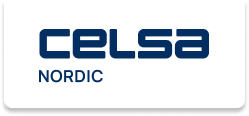Transparency Act
at CELSA Armeringsstål
Transparency Act at CELSA Armeringsstål

Celsa’s approach
Celsa’s Norwegian companies, Celsa Armeringsstål and Celsa Steel Service, have adapted their operations to the Act that enters into force on 1 July 2022 and have implemented processes to ensure that the companies comply with the conditions laid down by the Act.
The work has been based on the OECD’s Due Diligence Guidance for Responsible Business Conduct.
Supplier code
of conduct
Policy on responsible
business conduct
The
transparency ACT
The
transparency ACT
Supplier
code of conduct
Policy on responsible
business conduct
The
transparency ACT
English version
Norwegian version
The Transparency Act highlights a key area and creates new responsibilities for large Norwegian companies. The Act should ensure a more sustainable approach to human rights and decent working conditions throughout the companies’ supply chain. Many of the companies subject to the Act have supply chains with international catchment areas in an economy that is becoming constantly more globalised and interwoven. If many Norwegian companies systematise the work on uncovering risk and preventing human rights violations and indecent working conditions, the combined effect can be positive on international value chains.
With the help of legal expertise, the companies have drafted new guidelines for requirements to the supply chain’s relationship to decent working conditions and human rights. The guidelines have been presented as matters for the board in the companies and adopted by the boards as applicable rules for the companies going forward.
As an operationalisation of the new guidelines, a Supplier Code of Conduct (SCoC) has been developed that is distributed to the suppliers in the companies’ value chain. The SCoC expresses Celsa’s expectations to how these shall relate to human rights and requirements to decent working conditions going forward. These expectations will form the basis of Celsa’s dialogue with the suppliers on compliance with the obligations.
New agreement terms that will be included in contracts Celsa enters into with suppliers in the future have also been drawn up. This ensures that the companies’ work on following up the Transparency Act becomes a part of their operations.
Based on the new documents that have been developed, Celsa has conducted a materiality assessment of its own supply chain. This work has started with a review of the supply chain with a view to uncovering where possible risk occurs. By classifying the various suppliers according to proximity to Celsa’s core process and suppliers with possible high risk, the companies have been able to prioritise work on uncovering risk.
Celsa’s suppliers and partners are divided into the following categories:
X – not relevant for the due diligence assessment (Norwegian public agencies, Norwegian trade unions and special interest organisations)
1 – Little need for control, little proximity to operations and insignificant impact on Celsa’s core processes.
2 – Services that are widely used, but little affiliation with the core operations (courier services, other transport, etc.)
3 – Checked due to proximity to operations, without suspicion of risk (suppliers of scrap metal and other components and services key to Celsa’s core operations)
4 – Possible high risk, including as a result of deliveries to Celsa’s operations originating from other business cultures with less transparent conditions around human rights and working conditions.
The risk assessment has been based on the Norwegian Agency for Public and Financial Management’s (DFØ) guidelines for ethical trade. The Agency analyses countries that are relevant for trade for Norwegian companies. In addition, they have reviewed various sectors in a risk assessment.
The steel industry is deemed to have a high risk related to human rights violations and indecent working conditions. Among other things, this is because the industry is dominated by Chinese and Indian players. For Celsa’s work on the due diligence assessment, this implies that special attention is given to those parts of the supply chain that are affiliated with these countries.
v In the materiality assessment, Celsa has started the risk assessment with a review of the largest suppliers and partners in category 3 mentioned above, and have conducted a review of all with an annual engagement with Celsa of more than NOK 10 million. After reviewing these suppliers, all companies in category four have been reviewed to reveal whether there is a risk of or violations of human rights or requirements to decent working conditions.
In the assessment of the individual suppliers, emphasis has been on different factors and sources to seek and uncover risks. Deliveries from companies that come from Nordic and western countries have been considered to be less risky due to these being bound by statutes where the working environment is strictly regulated and human rights have a prominent place in legislation. However, it is stressed that this is not essential for the risk assessment, but is a factor that must be compared with other sources.
If these assesment reveal a negative impact on decent working conditions or human rights, Celsa will implement measures. The aim of the measures will be to restore a decent working environment at the relevant supplier or partner or to stop violations of human rights.
Depending on the type of negative impact in question, the measures may include dialogue with the supplier or partner, new requirements in connection with contract follow-up or other requirements and forms of cooperation that prove relevant to reduce the negative impact. In the extreme, the negative impact can lead to the termination of the contractual relationship. Furthermore, it is important for Celsa to follow implemented measures to ensure that these actually lead to reduced negative impact.
For those who have been harmed by the negative impact, it will be relevant for Celsa to ensure that compensation is provided – or even provides – compensation where this is a natural consequence of the impact that has occurred.


Companies who have developed their own guidelines for working environment and safety at the workplace, as well as a code of conduct that deals with these topics, are also considered to be of lower risk. When preparing such documents and entrenching these in the company’s management, one demonstrates a commitment to the themes and a willingness to avoid human rights violations and indecent working conditions.
Furthermore, it is viewed as a strong indication against risk and violations if a company has subjected to – and been approved for – external, international certification of the working environment. With such certification one has introduced procedures and practices to prevent negative influence and let an independent third party conduct investigations based on impartial standards. If the certification is relatively new, this is considered to be a strong signal that the company does not add a negative impact.
In addition to these factors, searches have been conducted in different online sources to uncover whether there have been incidents concerning the examined suppliers that indicate negative impact on human rights or decent working conditions.
The information collected on the individual supplier is collected in a memo where all factors emphasised in the assessment emerge. In addition, a schematic overview of the risk assessment with colour coding of likelihood and severity of negative impact linked to the individual supplier. Using a green, yellow and red colour scale, one has followed up those who have emerged with an overall value that is yellow or red, which indicates that there may be risks associated with the supplier.
After this process one has proceeded with the suppliers one has assumed have a certain risk. These have been contacted with requests for in-depth information relating to how they relate to human rights and decent working conditions, documentation on any own policies or external certification or other conditions that indicate their compliance with human rights and requirements to decent working conditions.
The process of assessing social sustainability in the supply chain will be implemented in the companies’ other management system for suppliers such that the assessments become a part of the continuous follow up of suppliers. With such an implementation one ensures that the follow-up of human rights and decent working conditions becomes a continuous process and can be improved as time passes.
By including the factors for the assessment of human rights and decent working life in the ordinary supplier follow-up, one also ensures that new suppliers are assessed before they enter into contractual relationships with Celsa.
You might be interested in reading about Celsa Nordic Sustainability Report.

